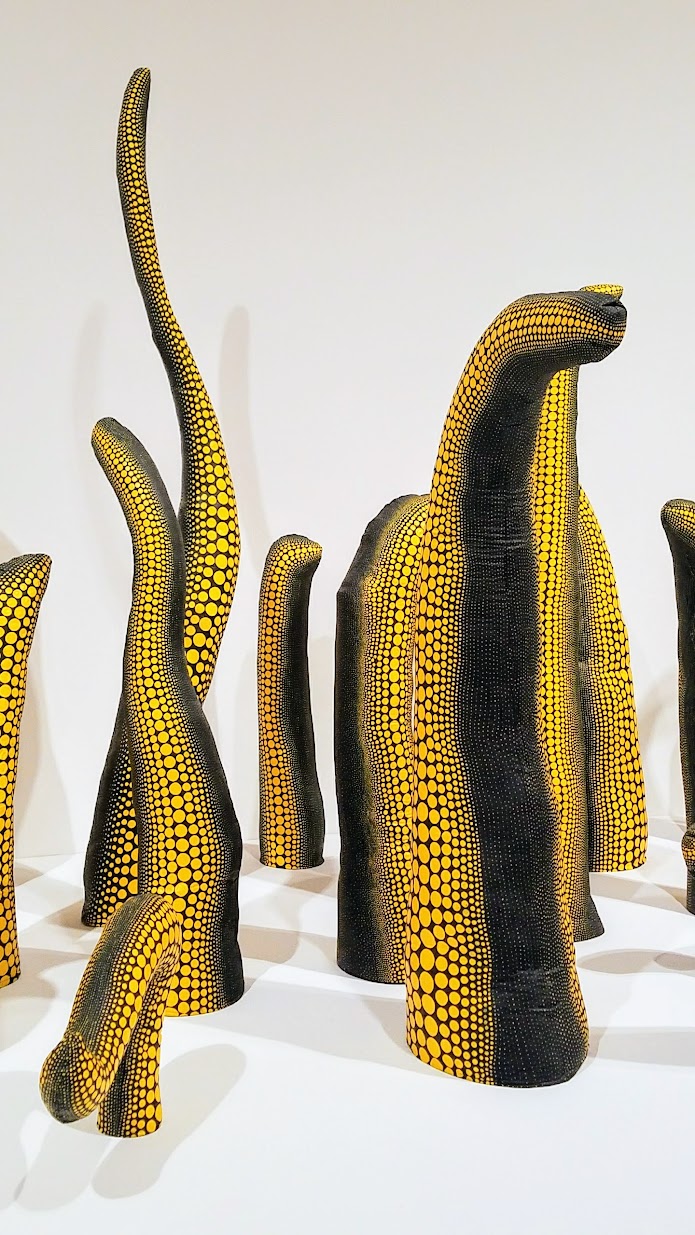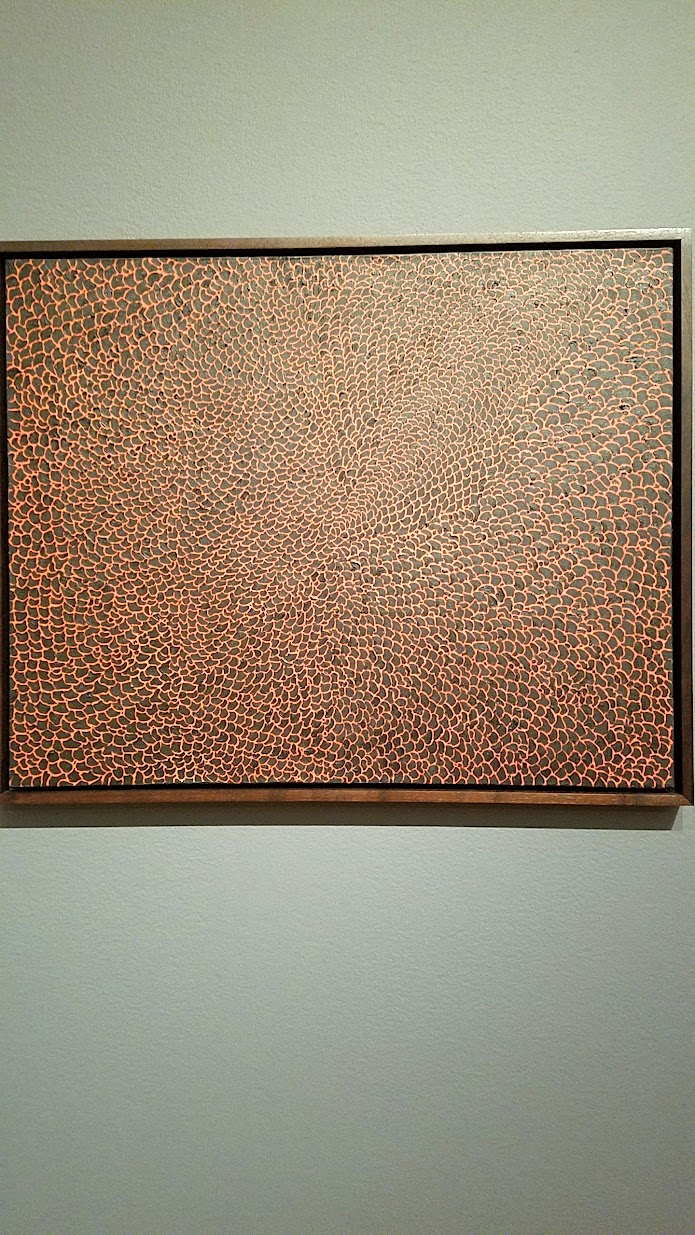There are no more advanced tickets available for the Yayoi Kusuma Infinity Mirrors exhibit in Seattle, but there are always tickets available for the day of your visit if you go there before the museum opens and line up to try getting the first come, first serve tickets at 10 AM. There are not many museums that will be displaying this incredible exhibition of 65 years of work by Yayoi Kusuma and bringing together the most Infinity Rooms into one place – in the US there are only four major museums. After Seattle the exhibit goes to The Broad in Los Angeles, and then it is off to Toronto Canada, Cleveland, and then Atlanta. The advanced tickets for the exhibit in The Broad go on sale at noon on September 1.


After a couple hours fighting the website on the online ticket sale day and their overwhelmed servers, I was able to get ticket for myself and 2 friends to visit the exhibit. So patience does pay off! Here is my Recap of Yayoi Kusama Infinity Mirrors at Seattle Art Museum which I hope may persuade you to make the trip to visit and see for yourself while you can. None of my photos or video really can do this justice – you just have to experience her artwork for yourself, in person. But, if you can’t make it, hopefully the photos give you at least an idea of how amazing Kusama is.


Overview of Yayoi Kusama
If you haven’t heard of Yayoi Kusuma before, the TLDR; is this: she was born in Japan in 1929, but came to the United States after World War 2 in her late 20s. She lived here through the free loving hippie time period and the Vietnam War in New York until the 1970s, when she returned to Japan and voluntarily checked herself a mental institution. She has lived there ever since, though she continues to produce artwork daily at a studio nearby even at her current age of 88. Kusama has said that “if it were not for art, I would have killed myself a long time ago.”


Ever since she was a child she has said she has experienced hallucinations that include light and dots, and she pulls from this to as you’ll see, incorporate polka dots through almost 7 decades of her abstract art. She repeats dots and patterns as part of her obsession with self-obliteration and infinity, with each dot symbolizing hope but also giving viewers a sense of both vastness and nothing, where there is both individual identity but it also dissolves into formlessness.


I work as much as fifty to sixty hours at a stretch. I gradually feel myself under the spell of the accumulation and repetition in my “nets” which expand beyond myself, and all over the limited space of canvas covering the floor, desk and everywhere; all of the universe which is actually visible –
I am always standing in the middle of the obsession against the passionate accumulation and repetition inside of me and am lost in the indescribable spell which is holding me
Under the Spell of Accumulation, Yayoi Kusama. Excerpt of an article from May 1961
The tickets into the exhibit itself are timed with groups entering every 15 minutes. In Seattle, you could line up about 25 minutes or so before your time slot – there is no food/drink allowed inside. In fact you will often by putting any purse or anything in hand besides your phone in cubby holes before entering some rooms. There is no restroom either, so plan accordingly.

Then while inside, while some artwork is just on display in a gallery style, there are also multiple experiences either in the form of “rooms” or “peep into a hole” that you must line up for in order to view the art in small groups of 3 or individually.
Since the rooms limit your time to 20-30 seconds though, you can expect lines to move relatively quickly – and yes you do wait in lines but you also get a chance to experience the Infinity Rooms in relative silence and privacy rather then surrounded by the distractions of tons of other people. I went into some Infinity Rooms more then once by lining up a few times, including where I just wanted to experience it without looking through any screen of a camera or phone.
Life (Repetitive Vision)
Yayoi Kusama, Life (Repetitive Vision), 1998 Stuffed cotton, urethane, paint, and wood


Tentacle-y? A bit of Ursula from The Little Mermaid? A bit phallic? Kusama has always been very bold and unapologetic in her feminism and sexual liberation. But there’s also a feeling of whimsy and energy with these yellow polka dots.


“A polka-dot has the form of the sun, which is a symbol of the energy of the whole world and our living life, and also the form of the moon, which is calm,” says Kusama. “Round, soft, colourful, senseless and unknowing. Polka-dots become movement … Polka dots are a way to infinity.”


Infinity Nets
Acrylic on Canvas
Text from the sign in the exhibit: Kusama created her Infinity Net paintings during her first years in New York, a time when she faced tremendous financial and emotional hardship. The repetitious motion of inscribing tiny arcs on a solid black background served as a meditation through which she made works “without composition – without beginning, end, or center.” Embodying the painterly qualities and the emphasis on process that are characteristic of abstract expressionism, these works also echo the seriality and monochromatic palettes of minimization.


Although repetitive, somehow each individual simple stroke group together into a flow of what seems like ocean foam swells and ebbs upon closer look then the initial stillness when you first see the painting. In 1998, one of her white on white Infinity Net paintings similar to below was auctioned at Christies in New York for $5,794,500, which was the highest price paid for a living female artist then. In 2014 another white on white Infinity Net sold at Christie’s New York for $7,109,000, so over multiple sales Kusama is currently the most expensive living female artist.


Accumulations
As a child, there was a riverbed with stones behind Kusama’s house that she was fascinated with.




Yayoi Kusama, Accumulation of Stardust, 2001 Acrylic on canvas
Yayoi Kusuma, Dots Obsession XZQBA, 2007 Acrylic on Canvas
Text from the sign in the exhibit: Kusama began making the Accumulations or “soft sculptures” in the early 1960s. Through creating countless soft phallic tubers and attaching them to furniture, the artist hoped to conquer her fear of sex and the phallus through a kind of self-therapy. Artworks made from sofa, chairs, stepladders, dressers, and a large table were presented together in Kusama: Driving Image Show”, a 1964 installation that functioned as a “total environment”. These sculptures serve as important precursors to her first Infinity Mirror Room, Infinity Mirror Room – Phalli’s Field (1965). Unlike in her sculptures and wall reliefs from this time, the tubers in Phalli’s Field emerge from the floor and are multiplied ad infinitum by surrounding mirrors to create an encompassing environment.


Yayoi Kusuma, Blue Spots, 1965 Stuffed cotton, kapok, and wood


Yayoi Kusuma, Red Stripes, 1965 Stuffed cotton, kapok, and wood

Yayoi Kusuma, Accumulation, 1962-65 Sewn and stuffed fabric with paint on wood chair frame
I find it very amusing thinking about how as a child Kusama used to sew parachutes for the WWII but as a free adult she has sewn how many hundreds of these phallic tubers! Also what does it mean that I really I really to squeeze one? Anyway… Back to serious art commentary
Text from the sign in the exhibit: Kusama returned to making sculptures in the mid-1970s, continuing to use phallic forms. She often coated these works with silver paint, evoking the reflective surfaces of her Infinity Mirror Rooms. The results are less organic than the early Accumulations, their sheen frozen and ethereal.





Yayoi Kusuma, Ennui, 1976 Sewn and stuffed fabric with silver paint and shoes
Yayoi Kusuma, Walking on the Sea of Death, 1981 Sewn and stuffed fabric, fiberglass rowboat, and silver paint
Phalli’s Field
1965/2016 Stuffed cotton, board, and mirrors.


Text from the sign in the exhibit: Kusuma spent much of her time between 1962 and 1964 sewing thousands of stuffed fabric tubers and grafting them to furniture and found objects to create her Accumulation sculptures. She exhibited the works together in an attempt to create hallucinatory scenes of phallic surfaces, but she found the labor involved in making them physically and mentally taxing. In response to the labor-intense nature of this work, she started to utilize mirrors to achieve similar repetition.


Text from the sign in the exhibit: Infinity Mirror Room – Phalli’s Field was perhaps the most important breakthrough for Kusuma during this immensely fruitful period. The reflective surfaces allowed her vision to transcend the physical limitations of her own productivity. Furthermore, the mirrors created a participatory experience by casting the visitor as the subject of the work, a feature that the artist demonstrated through a provocative series of self-portraits in which she used her body to activate the space.

I’ve given you a glimpse of one Infinity Room, but I have more Infinity Rooms and experiences to share – look for my next post next week for Infinity Room – Love Forever, Dots Obsession—Love Transformed into Dots, The Obliteration Room, guest favorite Infinity Mirrored Room—Aftermath of Obliteration of Eternity, and her series of sculptures My Eternal Soul and more.
What do you think of what I’ve shared so far about Yayoi Kusuma, what is your favorite or most fascinating to you of the art so far? I highly recommend visiting visiting this exhibit as I think it’s completely worth it. There are inherent biases in my photos since the photos are framed how I am looking at the art, and part of what I love about her work is how much different parts of so much detail you may be drawn to. Yes, she’s the queen of polka dots but there’s so much more.











I love the recap! I didn’t snag tickets in time and they went so quickly. I’ve seen some of her more object oriented works before but am most interested in experiencing one of her rooms – even just for 30 seconds.
This is fantastic! I hadn’t heard of her but I would like to see more in person. I wonder if she knew Isamu Noguchi? His museum was a big deal in my old NYC neighborhood. Thanks for highlighting this show, Pech!
Such a COOL exhibit! I loved seeing your Instagram posts on this!
That definitely sounds a little trippy, but what a great museum experience! So different!